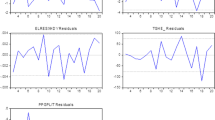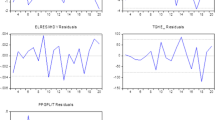Abstract
Conditional forecasts of US economic and energy sector activity are developed using information from a dynamic, data-rich environment. The forecasts are conditional on a path for carbon dioxide emissions outlined in the US Environmental Protection Agency’s Clean Power Plan (CPP) and are estimated based on a factor-augmented autoregressive framework. Results suggest that overall growth will be slower under the CPP than it would otherwise; however, economic growth and CO2 reductions can be achieved simultaneously. There are little differences between unconditional (business-as-usual) and conditional forecasts of the variables in the early part of the forecast period; the impacts of the CPP are small while the constraints on carbon dioxide are less stringent. The results serve as a data-driven complement to structural analyses of policy change in the energy sector.




Similar content being viewed by others
Notes
In addition to the causal structure outlined in Fig. 2, forecasts are generated from a model where the direction of flow from CO2 to factor 4 is reversed (i.e., factor 4 to CO2). Forecasting results are robust to this specification (industrial production has 3.97% annual growth in the conditional case and 3.92% annual growth in the unconditional case; real personal income 3.27% and 3.43%).
References
Bai J, Ng S (2002) Determining the number of factors in approximate factor models. Econometrica 70(1):191–221
Barnett A, Mumtaz H, Theodoridis K (2014) Forecasting UK GDP growth and inflation under structural change: a comparison of models with time-varying parameters. Int J Forecast 30(1):129–143
Bernanke BS (1986) Alternative explanations of the money-income correlation. Carn-Roch Conf Ser Public Policy 25:49–99
Bernanke BS, Boivin J, Eliasz P (2005) Measuring the effects of monetary policy: a factor-augmented vector autoregressive (FAVAR) approach. Q J Econ 120(1):387–422
Binder K (2016) The past, present, and future of the U.S. electric power sector: examining regulatory changes using multivariate time series approaches. Doctoral Thesis Texas A&M University. College Station, TX
Binder K, Pourahmadi M, Mjelde JW (2016) Forecasting oil prices using macroeconomic and supplementary variables: the role of temporal dependence in factor selection methods. Forthcoming Empirical Economics Texas A&M University College Station, TX
Bloor C, Matheson T (2011) Real-time conditional forecasts with Bayesian VARs: an application to New Zealand. North Am J Economics Finance 22(1):26–42
Burtraw D, Linn J, Palmer K, Paul A (2014) The costs and consequence of Clean Air Act regulation of CO2 from power plants. Am Econ Rev 104(5):557–562
Burtraw D, Bushnell J, Munnings C (2015) State and regional comprehensive carbon pricing and greenhouse gas regulation in the power sector under EPA’s Clean Power Plan. Resources for the Future Discussion Paper 15-31 https://papers.ssrn.com/sol3/papers.cfm?abstract_id=2630129 Accessed June 15, 2017
Burtraw, D., J. Linn, K. L. Palmer, A. Paul, K. McCormack, and H. Yin. 2016. Approaches to address potential CO2 emissions leakage to new sources under the Clean Power Plan. Washington DC: Resources for the Future
Bushnell JB, Holland SP, Hughes JE, Knittel CR (2017) Strategic policy choice in state-level regulation: the EPA’s Clean Power Plan. Am Econ J Econ Pol 9(2):57–90
Cai Y, Arora V (2015) Disaggregating electricity generation technologies in CGE models: a revised technology bundle approach with an application to the U.S. Clean Power Plan. Appl Energy 154:543–555
Chickering DM (2003) Optimal structure identification with greedy search. J Mach Learn Res 3(3):507–554
Clark TE, McCracken MW (2014) Evaluating conditional forecasts from vector autoregressions FRB of Cleveland. Working Paper No 14-13 http://papersssrncom/sol3/paperscfm?abstract_id=2504526 Accessed December 22, 2015
Datastream (2015) Thomson Reuters Datastream Subscription Service (TAMU Libraries) Accessed October 15, 2015
Doan T, Litterman R, Sims C (1984) Forecasting and conditional projection using realistic and prior distributions. Econ Rev 3(1):1–100
Duangnate K (2015) Essays on dynamics of and forecasting ability within the US energy sector. Unpublished Doctoral Thesis, Texas A&M University College Station, TX
Estima (2013) RATS Version 82 user’s guide. Evanston, IL
Favero CA, Niu L, Sala L (2012) Term structure forecasting: no-arbitrage restrictions versus large information set. J Forecast 31(2):124–156
Federal Reserve Bank of St Louis Economic Research (2015) FRED database. https://researchstlouisfedorg/fred2/ Accessed October 15, 2015
Hogan WH (2015) Electricity markets and the Clean Power Plan. Electr J 28(9):9–32
Hopkins J (2015) Modeling EPA’s Clean Power Plan: insights for cost-effective implementation. Center for Climate and Energy Solutions http://wwwc2esorg/publications/modeling-epas-clean-power-plan-insights-cost-effective-implementation Accessed February 2, 2016
Ielpo F (2015) Forward rates, monetary policy, and the economic cycle. J Forecast 34(4):241–260
Linn J, Burtraw D, McCormack K (2016) An economic assessment of the supreme court’s stay of the Clean Power Plan and implications for the future. Resources for the Future RFF DP16–21 http://www.rff.org/files/document/file/RFF-DP-16-21.pdf Accessed 1/1/2018
Moench E (2008) Forecasting the yield curve in a data-rich environment: a no-arbitrage factor-augmented VAR approach. J Econ 146(1):26–43
Pearl J (2000) Causality models, reasoning, and inference. Cambridge Press, Cambridge
Robertson JC, Tallman EW (1999) Vector autoregressions: forecasting and reality. Economic Rev Federal Reserve Bank Atlanta 84(1):4–18
Sims CA (1986) Are forecasting models usable for policy analysis? Federal Reserve Bank Minneapolis Quarterly Rev 10(1):2–16
Stock JH, Watson MW (2002a) Forecasting using principal components from a large number of predictors. J Am Statistical Assoc 97(460):1167–1179
Stock JH, Watson MW (2002b) Macroeconomic forecasting using diffusion indexes. J Bus Econ Stat 20(2):147–162
TETRAD V (2015) http://wwwphilcmuedu/projects/tetrad/currenthtml Accessed August 2015
Tsay R (2014) Multivariate time series analysis: with R and financial applications. John Wiley & Sons, Inc Hoboken, NJ
US Chamber of Commerce, Institute for 21st Century Energy (2014) Assessing the impact of proposed new carbon regulations in the United States. http://wwwenergyxxiorg/epa-regs# Accessed October 15, 2014
US Environmental Protection Agency (2015) Carbon pollution emission guidelines for existing stationary sources: electric utility generating units. Federal Register October 23, 2015 https://wwwgpogov/fdsys/pkg/FR-2015-10-23/pdf/2015-22842pdf Accessed December 21, 2015
Wang L, Faverao A, MA Brown (2016) An Economic assessment of low-carbon investment flows in the U.S. Power Sector. FEEM Working Paper No. 77.2016. https://papers.ssrn.com/sol3/papers.cfm?abstract_id=2887896 Accessed January 19, 2018
Zagaglia P (2010) Macroeconomic factors and oil futures prices: a data-rich model. Energy Econ 32(2):409–417
Author information
Authors and Affiliations
Corresponding authors
Additional information
The views expressed in this paper are those of the authors and do not necessarily reflect the position of the Federal Reserve Bank of Chicago, the Federal Reserve System, or Texas A&M University.
Electronic supplementary material
ESM 1
(PDF 256 kb)
Rights and permissions
About this article
Cite this article
Binder, K.E., Mjelde, J.W. Projecting impacts of carbon dioxide emission reductions in the US electric power sector: evidence from a data-rich approach. Climatic Change 151, 143–155 (2018). https://doi.org/10.1007/s10584-018-2297-9
Received:
Accepted:
Published:
Issue Date:
DOI: https://doi.org/10.1007/s10584-018-2297-9




